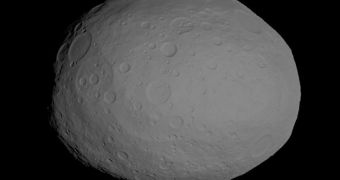More than 204 years after the initial discovery of the massive asteroid Vesta, NASA is finally gearing up to begin observing the large space rock directly. The Dawn spacecraft, which has been traveling through space for years, is now getting ready to enter orbit around the space boulder.
German astronomer Heinrich Wilhelm Olbers was the first to discovery Vesta, on March 29, 1807. Since then, the object has captured the attention of astronomers due to its unusual properties.
The fact that the object is called an asteroid is mainly a convention. Scientists decided to apply this designation because it lies in the Inner Asteroid Belt (IAB), which lies between Mars and Jupiter.
This region is filled with space rocks of all shapes and sizes, but features two remarkable components as well – Vesta and the dwarf planet Ceres. The latter is a target of the Dawn mission too.
The thing that immediately separates Vesta from other bodies in the IAB is its size. Whereas most other asteroids are around 100 kilometers (60 miles) in diameter, it is 530 kilometers (330 miles) across.
Over the years, astronomers even determined that some IAB objects are in fact pieces of Vesta, that were chipped off the massive space rock following impacts with other free-flying objects.
“I don't think Vesta should be called an asteroid. Not only is Vesta so much larger, but it's an evolved object, unlike most things we call asteroids,” Dawn co-investigator Tom McCord explains.
The expert is based at the Bear Fight Institute, in Winthrop, Washington. He adds that the object has a layered structure, in the sense that it features a core, a mantle and a crust, just like Earth does.
Vesta was also capable of sustaining a process called differentiation, which is basically when its interior divides into layers. In order for the process to take place, a body needs to contain large amounts fo radioactive materials when it forms.
Officially, this mysterious rock is not a proper planet or comet, but it can't be classified as an asteroid either. Scientists at the Jet Propulsion Laboratory (JPL), who manage Dawn, call it a “minor planet.”
They refine their classification even further by designating Vesta to be a protoplanet. This is a body that began forming in the Sun's protoplanetary disk around the same time Earth, Venus and Mars did, but for some reasons it did not have the necessary conditions to finish its development.
Experts now believe that Vesta did not develop further because it did not slam into other objects its size. This would have augmented its mass, and allowed it to grow at least as large as a dwarf planet.
“This gritty little protoplanet has survived bombardment in the asteroid belt for over 4.5 billion years, making its surface possibly the oldest planetary surface in the solar system,” Christopher Russell says.
“Studying Vesta will enable us to write a much better history of the solar system's turbulent youth,” adds the expert, who is the principal investigator of the Dawn mission. He is based at the University of California in Los Angels (UCLA).
“Dawn's ion thrusters are gently carrying us toward Vesta, and the spacecraft is getting ready for its big year of exploration,” adds JPL Chief Dawn Engineer Marc Rayman,
“We have designed our mission to get the most out of this opportunity to reveal the exciting secrets of this uncharted, exotic world,” he concludes.

 14 DAY TRIAL //
14 DAY TRIAL //